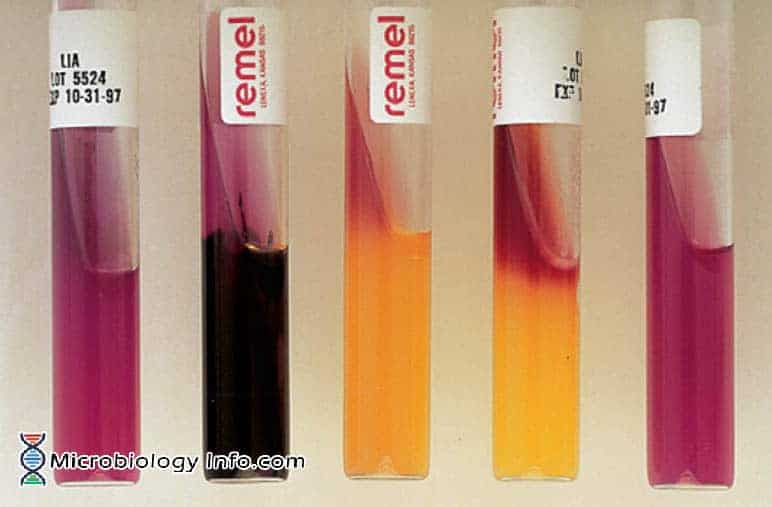Lysine iron agar (LIA) slants tests organisms for the ability to deaminate lysine or decarboxylate lysine. Lysine deamination is an aerobic process which occurs on the slant of the media. Lysine decarboxylation is an anaerobic process which occurs in the butt of the media.
Principle
Lysine iron agar contains lysine, peptones, a small amount of glucose, ferric ammonium citrate, and sodium thiosulfate. The medium has an aerobic slant and an anaerobic butt.
When glucose is fermented, the butt of the medium becomes acidic (yellow). If the organism produces lysine decarboxylase, cadaverine is formed. Cadaverine neutralizes the organic acids formed by glucose fermentation, and the butt of the medium reverts to the alkaline state (purple).
If the decarboxylase is not produced, the butt remains acidic (yellow). If oxidative deamination of lysine occurs, a compound is formed that, in the presence of ferric ammonium citrate and a coenzyme, flavin mononucleotide, forms a burgundy color on the slant. If deamination does not occur, the LIA slant remains purple. Bromocresol purple, the pH indicator, is yellow at or below pH 5.2 and purple at or above pH 6.8.
Media:
Lysine iron agar or LIA is a differential media used to distinguish bacteria that are able to decarboxylate lysine and/or produce hydrogen sulfide from those that cannot.
Enzymatic digest of gelatin (5 g), yeast extract (3 g), dextrose (1 g), L-lysine (10 g), ferric ammonium citrate (0.5 g), sodium thiosulfate (0.04 g), bromocresol purple (0.02 g), agar (13.5 g), per 1000 mL, pH 6.7.
Peptone and yeast extract provide essential nutrients. Dextrose is a source of fermentable carbohydrate. Ferric ammonium citrate and sodium thiosulphate are indicators of H2S formation. Cultures that produce hydrogen sulphide cause blackening of the medium due to ferrous sulphide production.
Method
- The medium is tubed, sterilised and slanted so that a short slant and deep butt are formed.
- With a straight inoculating needle, inoculate LIA by twice stabbing through the center of the medium to the bottom of the tube and then streaking the slant.
- Cap the tube tightly and incubate at 35°-37°C in ambient air for 18 to 24 hours.
- Examine at 18 – 24 and 40 – 48 hours for growth and color changes in tube butt and slant, and for blackening at the apex of slant.
Expected Results
Lysine iron agar. A, Alkaline slant/alkaline butt (K/K). B, Alkaline slant/alkaline butt, H2S positive (K/K H2S+). C, Alkaline slant/acid butt (K/A). D, Red slant/acid butt (R/A). E, Uninoculated tube.
Lysine Decarboxylation (detected in butt):
- Positive Test: Purple slant/purple butt (alkaline), the butt reaction may be masked by H2S production
- Negative Test:Purple slant/yellow butt (acid), fermentation of glucose only
Lysine Deamination (detected on slant):
- Positive Test:Red slant
- Negative Test:Slant remains purple
H2S Production:
- Positive Test:Black precipitate
- Negative Test:No black color development
- Gas production:demonstrated by the presence of bubbles or cracks in the medium
Uses
- This test is used to differentiate gram-negative bacilli based on decarboxylation or deamination of lysine and the formation of hydrogen sulfide (H2S).
- It employs a sensitive medium for the detection of lactose-fermenting and non lactose-fermenting salmonellae.
- Lysine Iron Agar is specified in standard methods for Salmonella testing.
Limitations
- It is recommended that biochemical, immunological, molecular, or mass spectrometry testing be performed on colonies from pure culture for complete identification.
- It is important to stab the butt of the medium. Failure to stab the butt invalidates this test.
- LIA is not as sensitive in detecting hydrogen sulfide in comparison to other iron containing mediums, such as Sulfide Indole Motility (SIM) Medium and TSIA.
- Proteus sp. that produces hydrogen sulfide will not blacken the medium.
- Certain species or strains may give delayed reactions or completely fail to ferment the carbohydrate in the stated manner.
- Gas production may be irregular or suppressed with organisms other than Citrobacter spp.
References
- Tille, P. M., & Forbes, B. A. (2014). Bailey & Scott’s diagnostic microbiology (Thirteenth edition.). St. Louis, Missouri: Elsevier.
- himedialabs.com/TD/M377.pdf
- www.oxoid.com/UK/blue/prod_detail/prod_detail.asp?pr=CM0381&c=UK&lang=EN
- iws2.collin.edu/dcain/CCCCD%20Micro/lysine_iron_agar.htm
- https://assets.thermofisher.com/TFS-Assets/MBD/Instructions/IFU453772.pdf
- foodsafety.neogen.com/pdf/acumedia_pi/7211_pi.pdf


Isn’t an acid environment needed (yellow butt) for the production of H2S? If purple butt, H2S capability of organism would be unknown. Isn’t this why LIA slants are not a sensitive method of H2S production compared to TSI or KIA slants?
our test result in LIA was burgundy slant and brown butt what happened?